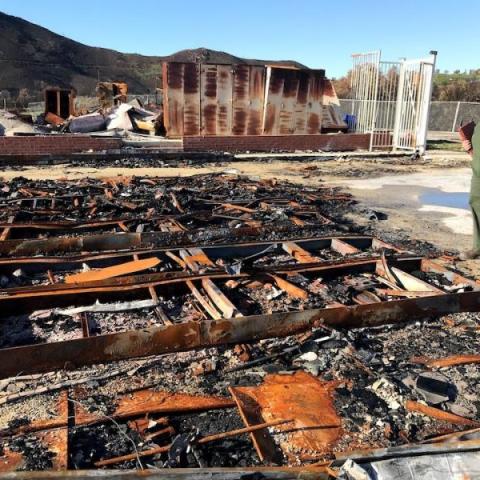
Post-Woolsey Fire debris at Western Town in Santa Monica Mountains NRA/NPS
A year after a wildfire burned across 88 percent of the federal landscape in Santa Monica Mountains National Recreation Area crews are beginning the dirty task of removing debris and potentially hazardous materials from 30 structures that burned down. The Woolsey Fire also damaged 112 miles of trails as it burned across the landscape.
Unfortunately, the National Park Service is not eligible for the assistance provided by the Federal Emergency Management Agency for cleaning up burned sites. FEMA has provided contaminant clean-up through the California Office of Emergency Services for most private landowners, local, and state governments impacted by the Woolsey Fire.
“We needed separate funds from Congress to begin work,” said park Superintendent David Szymanski.
In June, Congress passed and President Trump signed a Disaster Relief Bill. Santa Monica Mountains National Recreation Area received a share of these funds in August and awarded a contract for site clean-up the following month.
Strict environmental rules govern the treatment of contaminated sites. The process involves rigorous testing before and after treatment to ensure that materials are disposed of properly and that the site is cleaned to accepted standards.
“Since all buildings have toxins in them when they burn, testing for hazardous materials is a critical step that must be taken prior to the removal of any of the debris,” Szymanski said. “As caretakers for the public’s lands, we are required to guarantee that all toxins have been removed. We can’t just use our park equipment and haul everything off.”
A minority-owned business based out of Thousand Oaks, California, Lead Builders, Inc., was awarded a $1.6 million contract in September to remove and haul debris from the various sites within the recreation area. The debris consists of vegetation, ash, contaminated soil, trees that prohibit work performance, household hazardous waste, and electronic waste.
After the testing process is completed early next year, the contractor will remove and haul debris from the 30 structures and outbuildings. This aspect of the project is expected to begin in the spring of 2020.
The park has focused on reopening trails and park sites. Over the past year, park rangers worked to open these trails, clear roads, stabilize hillsides, repair culverts and conduct surveys on bridges that were in need of repair. Currently, 103 miles of the 112 that were burned have reopened. In addition, 1,000 acres of invasive plants were treated.
The park expects to open two more park units - Peter Strauss Ranch and Rocky Oaks - before Thanksgiving.


 Support Essential Coverage of Essential Places
Support Essential Coverage of Essential Places






